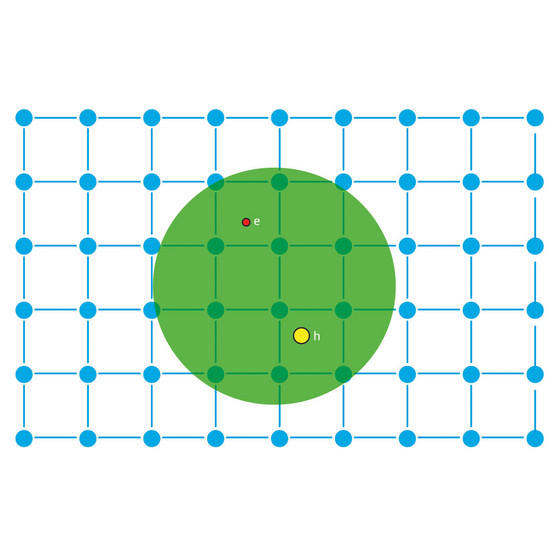Home > Press > Free from approximations
 |
| Figure 1: Schematic of an exciton in a host lattice. The electron (red) and the hole (yellow) that constitute the exciton are held together by the Coulomb attraction (represented by the green circle). |
Abstract:
A novel numerical technique permits researchers to study the interaction between elementary particles within a material without approximations
Free from approximations
Japan | Posted on January 15th, 2009An international team of researchers has developed a numerical modeling technique to study specific types of particles called excitons, which consist of a positively and a negatively charged electron and hole, respectively. The technique includes the influence of a material's internal structure—the so-called host lattice—without the need to make approximations of any sort1.
In an exciton, the electron and the hole are bound together by an electric attraction—known as the Coulomb force (Fig. 1)—in a fashion very similar to that of an electron and a positron in a hydrogen atom. The presence of the host lattice and its thermal and magnetic excitations that consist of phonons and magnons, respectively—known collectively as the ‘bosonic' field—can affect the excitons considerably.
The researchers, including Andrei Mishchenko from the RIKEN Advanced Science Institute in Wako, aimed to develop a technique to study the excitons' interaction with phonons in an exact way. In particular, they focused on taking into consideration the fact that phonons do not act instantaneously as occurs in the Coulomb attraction. "Previously, the only way to treat the exchange [between electrons and holes] by bosons was an instantaneous approximation, where the influence of particle-boson interaction was included into the model by renormalization of the instantaneous coupling," explains Mishchenko.
Mishchenko and colleagues' technique is known as a Diagrammatic Monte Carlo Method and is based on the diagrams that the Nobel laureate Richard Feynman introduced to quantum field theory. The method per se existed already and was normally used with all variables expressed as a function of spatial coordinates. This, however, limits the size of the area that can be examined in a calculation. The team therefore formulated the algorithm for momentum space. This provides the "possibility to overcome the limitation of the direct space method [for] finite systems and handle the problem [in] a macroscopic system," says Mishchenko.
Like any new theoretical method, the team's numerical technique must be compared with known scenarios to verify its validity, so Mishchenko and colleagues used it to study excitons with different values for the electron and hole masses. They found very good agreement with previous theories within the limit in which it is reasonable to neglect any retardation effect. Importantly however, the results show that in standard conditions it is incorrect to neglect the retardation.
As Mishchenko explains: "Our ‘free-from-approximations' results show that the domain of validity of the instantaneous approximation is very limited."
Reference
1. Burovski, E., Fehske, H. & Mishchenko, A.S. Exact Treatment of Exciton-Polaron Formation by Diagrammatic Monte Carlo Simulations. Physical Review Letters 101, 116403 (2008).
The corresponding author for this highlight is based at the RIKEN Theoretical Design Team
####
For more information, please click here
Copyright © Riken
If you have a comment, please Contact us.Issuers of news releases, not 7th Wave, Inc. or Nanotechnology Now, are solely responsible for the accuracy of the content.
| Related Links |
| Related News Press |
News and information
![]() Researchers develop molecular qubits that communicate at telecom frequencies October 3rd, 2025
Researchers develop molecular qubits that communicate at telecom frequencies October 3rd, 2025
![]() Next-generation quantum communication October 3rd, 2025
Next-generation quantum communication October 3rd, 2025
![]() "Nanoreactor" cage uses visible light for catalytic and ultra-selective cross-cycloadditions October 3rd, 2025
"Nanoreactor" cage uses visible light for catalytic and ultra-selective cross-cycloadditions October 3rd, 2025
Physics
![]() Quantum computers simulate fundamental physics: shedding light on the building blocks of nature June 6th, 2025
Quantum computers simulate fundamental physics: shedding light on the building blocks of nature June 6th, 2025
![]() A 1960s idea inspires NBI researchers to study hitherto inaccessible quantum states June 6th, 2025
A 1960s idea inspires NBI researchers to study hitherto inaccessible quantum states June 6th, 2025
![]() Magnetism in new exotic material opens the way for robust quantum computers June 4th, 2025
Magnetism in new exotic material opens the way for robust quantum computers June 4th, 2025
Discoveries
![]() Researchers develop molecular qubits that communicate at telecom frequencies October 3rd, 2025
Researchers develop molecular qubits that communicate at telecom frequencies October 3rd, 2025
![]() Next-generation quantum communication October 3rd, 2025
Next-generation quantum communication October 3rd, 2025
![]() "Nanoreactor" cage uses visible light for catalytic and ultra-selective cross-cycloadditions October 3rd, 2025
"Nanoreactor" cage uses visible light for catalytic and ultra-selective cross-cycloadditions October 3rd, 2025
Announcements
![]() Rice membrane extracts lithium from brines with greater speed, less waste October 3rd, 2025
Rice membrane extracts lithium from brines with greater speed, less waste October 3rd, 2025
![]() Researchers develop molecular qubits that communicate at telecom frequencies October 3rd, 2025
Researchers develop molecular qubits that communicate at telecom frequencies October 3rd, 2025
![]() Next-generation quantum communication October 3rd, 2025
Next-generation quantum communication October 3rd, 2025
![]() "Nanoreactor" cage uses visible light for catalytic and ultra-selective cross-cycloadditions October 3rd, 2025
"Nanoreactor" cage uses visible light for catalytic and ultra-selective cross-cycloadditions October 3rd, 2025
|
|
||
|
|
||
| The latest news from around the world, FREE | ||
|
|
||
|
|
||
| Premium Products | ||
|
|
||
|
Only the news you want to read!
Learn More |
||
|
|
||
|
Full-service, expert consulting
Learn More |
||
|
|
||








